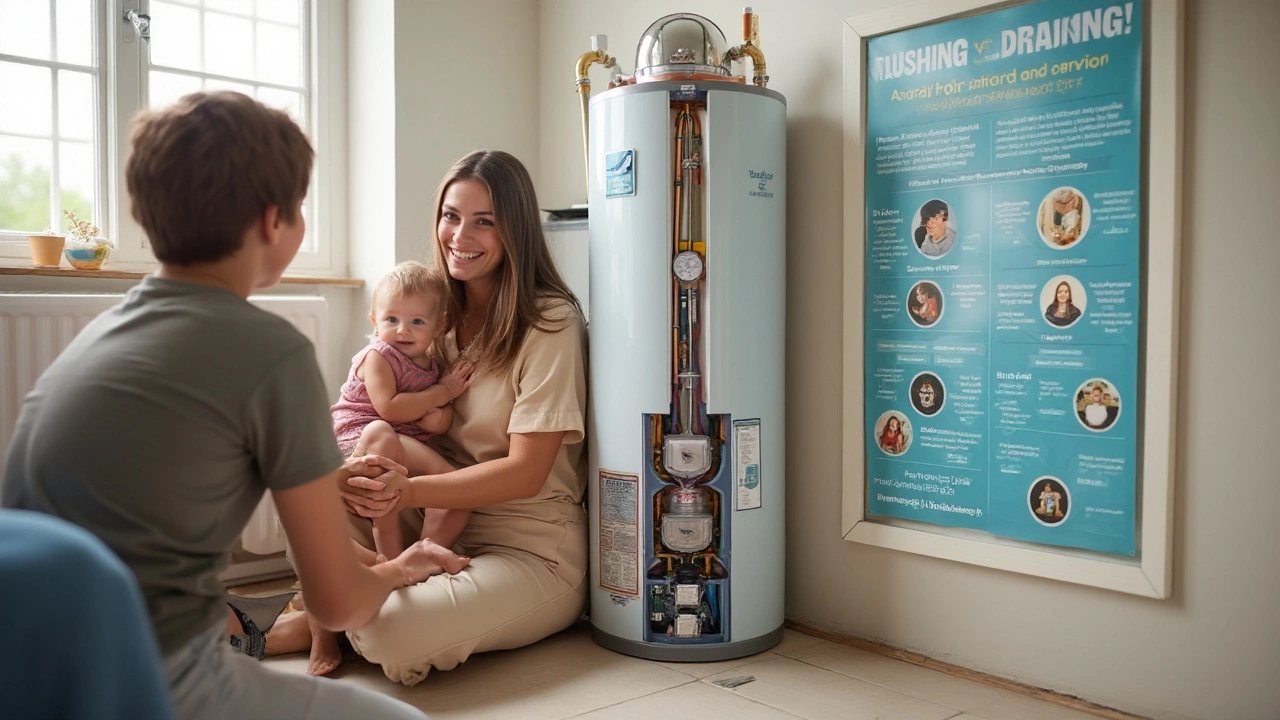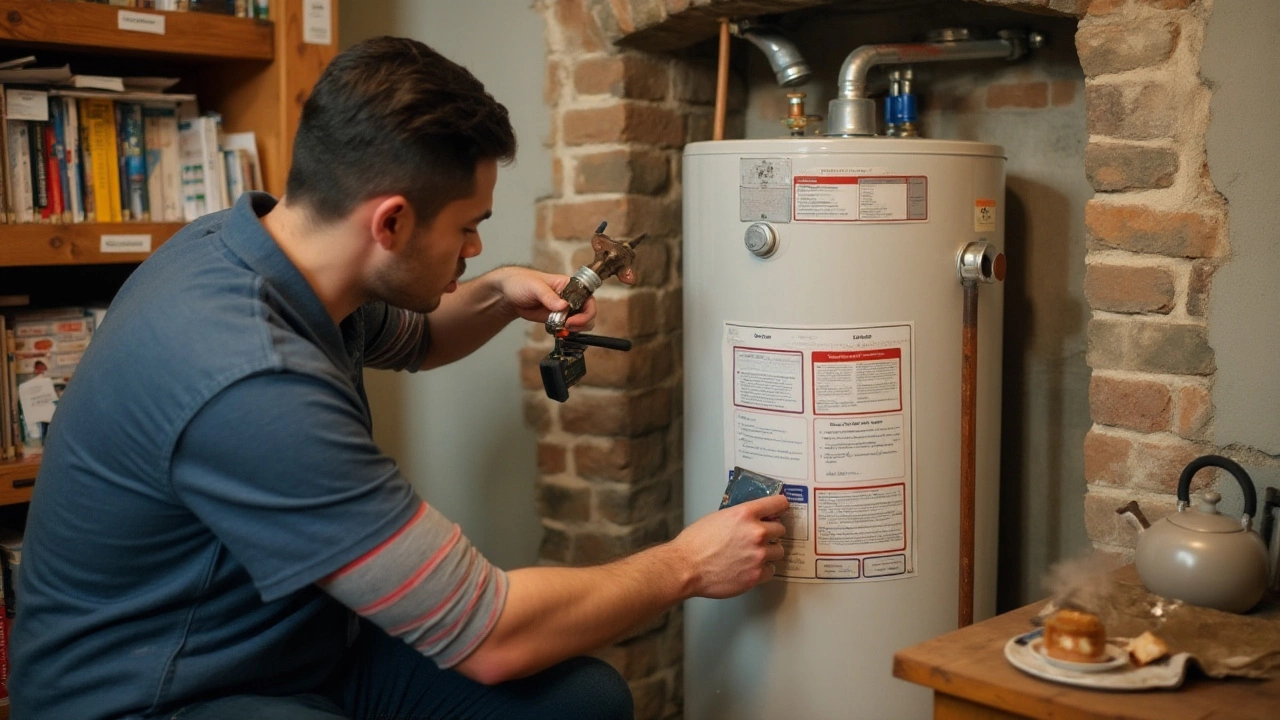Water heaters, unsung heroes of household utility, quietly deliver warm showers and clean dishes day after day. But like any loyal appliance, they need some love and attention to keep performing their best. One perennial question looms large: is it better to flush or drain your water heater?
With a variety of opinions floating around, it's easy to feel a tad overwhelmed. Each method has its own set of benefits and specific situations where it excels. Whether you're dealing with a lightweight tank-style heater or a more complex tankless system, understanding these differences is key to ensuring you make the right choice.
In exploring this topic, we’ll dive into the reasons behind regular maintenance, the practical steps involved in flushing or draining, and offer tips to maintain your water heater’s efficiency for seasons to come. We aim to arm you with the knowledge not only to make an informed decision but also to enhance the overall longevity and performance of your trusty water heater.
- Understanding Water Heaters
- Why Maintenance Matters
- Flushing vs Draining: Pros and Cons
- Step-by-Step Flushing Guide
- Step-by-Step Draining Guide
- Tips for Long-term Efficiency
Understanding Water Heaters
Water heaters come in many shapes and sizes, yet they all serve the essential purpose of delivering hot water to homes and businesses. These systems typically fall into two categories: tank-style and tankless. The former stores a heated supply of water, ready for use when needed, while the latter heats water on demand. Each type comes with its own set of benefits and considerations, which can significantly influence maintenance requirements and energy efficiency. For instance, tank-style systems often require regular sediment removal—known as flushing—to maintain their heating efficiency, while tankless systems emphasize regular checks on flow rates and potential scale buildup.
The humble tank-style water heater, characterized by its cylindrical design, has long been a staple in residential homes. It's an apparatus many of us are familiar with, yet frequently overlook due to its silent, often hidden operation. Typically, these units hold between 20 to 80 gallons of water, continuously heating to maintain a steady supply of hot water. Many experts recommend regular maintenance to prevent the buildup of sediment, which can impede heating and reduce efficiency. The Department of Energy notes that sediment accumulation can cause a tank-style heater's energy usage to increase by up to 15%, leading to higher utility bills.
On the opposite end of the spectrum, the sleek tankless water heater boasts efficiency, providing hot water without the need to store large volumes of it. These systems are highly efficient as they operate only on-demand, reducing the wasted energy endured in constantly heating a reservoir of water. According to a study by Consumer Reports, tankless heaters are approximately 30% more energy-efficient than traditional tanks, which translates to significant savings in the long run, especially in homes that use a lot of hot water. However, it’s crucial to regularly check for mineral buildup in these systems to ensure optimal performance.
According to John Banta, a lead expert with Consumer Reports, "While tank-type water heaters require some space, their initial installation cost is less. However, the tankless versions, though pricier upfront, offer energy savings that can pay off in the long term."
In considering these two types of water heaters, it is essential to weigh factors such as energy efficiency, space availability, and cost. A tank model might be more feasible for budget-conscious individuals and households with moderate hot water consumption. Meanwhile, for those willing to invest upfront aiming for efficiency and space conservation, a tankless system could be the way to go. Whichever type you choose, understanding the maintenance needs, such as whether to flush or drain, can lead to improved longevity and operational efficiency. Knowing the ins and outs of these systems sets the stage for more focused topics like maintenance, helping you maintain peak performance and energy efficiency wherever water flows.
Why Maintenance Matters
Regular water heater maintenance isn't just a smart idea—it's essential for extending the life of the appliance and ensuring optimal performance. Calcium and other mineral deposits don’t take long to accumulate, and when they do, they can create an insulating layer on heating elements, rendering the system inefficient. Such inefficiencies lead to increased energy consumption, which might reflect starkly on your monthly utility bills. The sediment can also cause overheating, resulting in the tank needing to work harder, which can eventually lead to premature failures that are both costly and inconvenient.
Manufacturers recommend flushing your water heater regularly, depending on the hardness of the water in your area. What many homeowners don't realize is that hard water – water with high mineral content – can speed up the accumulation of sediment inside the tank. This not only leads to operation inefficiencies but can also lead to less hot water availability, affecting your routine. The accumulation can hinder the proper functioning of various components, leading to inconsistent heating temperatures, or in worst cases, bacterial growth due to tepid water unable to reach recommended temperatures to kill off harmful bacteria.
Neglecting basic maintenance might also play a significant role in voiding your warranty. Many manufacturers clearly state in their warranty conditions that damages caused by lack of maintenance are not covered, leaving you with the burden of repair or replacement. According to home improvement expert Bob Vila, "Routine maintenance not only ensures your heater runs efficiently but can also void clauses that manufacturers rely on for avoiding warranty claims."
"A little preventative action goes a long way in keeping home appliances in prime condition," notes Bob Vila, highlighting the importance of routine checks.
When it comes to flush water heater practices, imagine keeping your car filled with clean oil. Just as dirty oil can damage your vehicle’s engine, the same is true for dirty water within the heater tank. Debris inside is abrasive and can cause significant wear and tear on the tank components over time. Regular checks can help spot small issues before they escalate into major problems. Consider adopting a routine where you check the condition of the anode rod—the unsung hero within your water heater. This rod attracts corrosive elements in the water, offering protection to the tank itself, but it does deteriorate over time, necessitating replacement for continuous protection.
Moreover, planned maintenance contributes directly to the safety of your household. Water heaters, if not taken care of properly, can become ticking time bombs. Pressure build-up from a faulty valve can lead to dangerous situations, even explosions, in extreme cases. Adopting consistent maintenance protocols could prevent such mishaps and provide peace of mind by reducing the risks significantly.
Statistical data from the Energy Information Administration highlights that water heating accounts for nearly 18% of total energy use in an average American home, making it the second-largest energy expenditure. Therefore, maintaining a smooth-operating water heater can substantially impact your home’s energy efficiency, saving both energy and cost. Seeing maintenance as an investment rather than an expense provides not only economic benefits but lengthens appliance longevity, further serving your household efficiently.

Flushing vs Draining: Pros and Cons
When it comes to maintaining your water heater, choosing between flushing and draining isn't just a throwaway decision. These two processes, though seemingly similar, have distinct purposes and benefits. Flushing a water heater involves circulating fresh water through the tank to remove sediment that settles at the bottom during use. This process is like giving your water heater a shower, targeting the gunk and buildup that can reduce efficiency. Regular flushing can extend your tank’s life, keeping that hot water flowing without interruption. On the flip side, draining a water heater involves emptying it completely, often an ideal choice when you're shutting it down for the season or need to make extensive repairs. Draining is more of a heavy-duty cleanup, best for long-term maintenance needs.
The advantages of flushing are its simplicity and the way it addresses sediment build-up, which can cause corrosion or lead to inefficient heating. Industry experts emphasize that regular flushing at least once a year can enhance a heater's efficiency by up to 30%. However, if not done properly, it might not remove all sediments. Conversely, draining allows a complete reset, which some homeowners prefer for thoroughness. But it requires more time and effort, and improperly drained tanks can invite air pockets that may cause damage when refilled. According to the Water Quality Association, "Regular maintenance of water heaters not only preserves household energy efficiency but significantly reduces the carbon footprint of hot water use."
In weighing these options, consider your specific needs. If your water heater is struggling with sediment, a flush might suffice. However, if you’re introducing a long-term maintenance schedule or addressing frequent issues, a full drain might be beneficial. It also depends on the heater type. For instance, tankless models, while less prone to sediment, still benefit from routine flushing to maintain efficiency. It’s this balance of time and resources, combined with a keen eye on the device's health, that can help ensure you make the right choice. Whether opting for a flush or a full-on drain, attention to detail and regularity in maintenance are key. Knowing the differences can save you from bigger headaches down the road and keep the hot water where it’s needed most—right at your fingertips.
Step-by-Step Flushing Guide
Flushing your water heater is akin to giving it a detox. It involves removing sediment buildup that can hinder performance and reduce efficiency over time. If left unattended, sediment can solidify and cause your heating element to work overtime, increasing your energy bills and potentially leading to premature failure. The good news is that flushing a water heater is a straightforward task that most homeowners can tackle with a bit of patience and the right tools. The benefits include not just an efficiently running system but also improved water quality, which you can both see and feel.
Gathering Your Tools
Before you start, ensure you have the necessary tools on hand. You will need a garden hose, a bucket, and an adjustable wrench. Also, familiarize yourself with your water heater's components, such as the drain valve and the temperature-pressure relief valve. A helpful tip is to have a tarp or old towels around to catch any potential spills. Safety is key, so make sure to turn off the power supply to your water heater before beginning the flush. If you're dealing with a gas water heater, set the thermostat to the "pilot" setting.Preparing for the Flush
Start by turning off the cold water supply. This prevents new water from entering the tank as you drain out the old, sediment-laden water. Attach a garden hose to the drain valve at the bottom of the water heater tank. Direct the opposite end of the hose to a nearby floor drain or outside. Once everything is set up, open a hot water faucet somewhere in your house to allow air to enter the tank. This step ensures there are no vacuum locks during the draining process, making it smoother and more efficient.- Open the Drain Valve: Carefully open the water heater's drain valve, allowing the tank water to flow through the hose. Be cautious here; the water can be scalding hot, so ensure no one touches the open end of the hose. Let the tank drain completely.
- Flushing the Tank: Once drained, turn the cold water supply back on briefly. This will help stir up any remaining sediment, expelling it through the hose. You may need to repeat this process several times until clear water flows.
- Refilling the Tank: Close the drain valve securely and remove the hose. Then, turn back on the cold water supply and let the tank fill. Immediately open a few hot water faucets again to purge any trapped air from the system.
"Regular flushings are a simple step to extend the life of your water heater and improve its efficiency," says plumbing expert Alex Milton. "It’s an often-overlooked task that can make a huge difference."Once the tank is full, return the heater back to its original power setting, or if it’s a gas model, switch the thermostat from "pilot" to your desired temperature setting. Routine maintenance like this teaches us all a bit about the workings of our homes, encouraging a sense of responsibility for the appliances we often take for granted.

Step-by-Step Draining Guide
When it comes to draining your water heater, the task might sound intimidating, but with some clear instructions and a bit of patience, you’ll find it’s entirely manageable. Before starting, remember that safety is your number one priority. You are working with an appliance that deals with hot water and electric or gas supplies, so being cautious is key. Start by turning off the power supply. If your water heater is electric, find the circuit breaker and switch it off. For gas heaters, there should be a dedicated valve to turn off the gas flow. This ensures that you’re stopping energy flow, preventing any unwanted trouble during the process.
Now, let the water inside the heater cool. It might take a while, so be prepared for a bit of wait time — we’re talking an hour or even longer, depending on the size of your tank. Next up, head to that handy-dandy drain valve located at the tank's bottom. It’s a good time to find the nearest sink or floor drain, as this is where your water is going to exit. Attach a standard garden hose to the valve, making sure it’s threaded tightly and leads to your desired drainage spot. A pro-tip here is to create a siphoning effect, ensuring water flows out smoothly. Once your hose is set, open a hot water tap in your home. This simple action relieves pressure inside the tank, allowing gravity to do its job more effectively.
"Preventive maintenance is key to avoiding costly repairs and prolonging appliance life," suggests plumbing expert John Miller in his interview with DIY Plumber's Digest.
This idea of pressure relief is crucial. As you open the drain valve, you should see water begin to flow. If you've never drained your heater before, expect the initial water to appear mucky. It's normal; this murkiness is sediment that has settled at the tank's bottom. Sediments can contribute to clogs within the water heater, leading to inefficiencies or even premature wear-out. In severe cases, sediment buildup can cause internal parts of the heater to overheat, leading to strange popping noises as trapped air struggles to escape. With patience, allow the water to continue draining until it reduces to a slow trickle.
After you have thoroughly drained the water, you’ll likely want to flush the tank. This involves reintroducing a bit of fresh water back into the heater. By strategically opening and closing the drain valve while the water source is turned on, you can help agitate any residual sediment, forcing it out through the hose. It’s an optional, yet highly recommended step for maintaining your heater’s peak efficiency. When you’re satisfied with the final water clarity, proceed to close the drain valve and remove the hose.
Now it's time to refill the tank. Ensure the hot water tap inside your home remains open. Turn the cold water supply back on, allowing the tank to gradually fill. This step not only fills the heater but also purges any lingering air pockets within the plumbing. You’ll know it’s full when water runs out of your tap. Finish off by restoring power to your heater. For electric models, flip the breaker back on, and if gas is your energy source, relight the pilot light following the manufacturer's instructions. Keep an ear out for signs that the heater is functioning optimally. Remember, this regular water heater maintenance ritual can save you from costly headaches and ensure a steady supply of hot water in your home.
Tips for Long-term Efficiency
Ensuring your water heater maintenance is on point not only saves money but also extends the lifespan of your unit. A well-maintained heater can last a decade or more, reducing the need for costly replacements and keeping your energy bills in check. Starting with regular inspections is crucial. Checking for leaks, ensuring valves function properly, and inspecting the tank's insulation can help identify issues early. It's worthwhile to set a regular reminder to examine these aspects of your system.
Setting the thermostat to an optimal temperature can make a significant difference in efficiency. Most experts recommend keeping it at 120 degrees Fahrenheit. This temperature prevents scalding, reduces energy usage, and helps delay mineral build-up inside the tank. Mineral deposits are the silent culprits behind many inefficiencies. Regularly cleaning these deposits ensures your heater works smoothly. To avoid sediment hardening, annual or semi-annual flushing of the unit is vital. Use this opportunity to assess the anode rod for corrosion, a part integral to prolonging the system's life.
Water heaters aren't one-size-fits-all when it comes to maintenance. Know the specifications and requirements of your particular model. This knowledge empowers you to prioritize certain maintenance tasks over others based on your water heater's unique demands. Consulting your manual can be invaluable. On occasion, enlisting the help of a professional for more thorough checks can be wise. Adopting energy-efficient practices like insulating your water heater or investing in an efficient model keeps utility bills low and reduces environmental impact.
Sometimes, innovations push us toward better ways of doing things. The last decade has seen an impressive stride in tech-related plumbing tips. For instance, Wi-Fi-enabled heaters allow for remote temperature adjustments and energy usage tracking. These smart systems are designed with preventive measures in mind, notifying you about necessary maintenance before problems arise. Businesses are now leaning towards these advancements since a study showed smart heater users recorded a 20% increase in efficiency.
"Maintaining your appliances isn't just about preventing problems. It's about preserving functionality and maximizing lifespan." - Home Appliance Magazine
Another often overlooked but game-changing tip involves wrapping the pipes leading from your water heater with insulating material. Common practice during colder months, but it can realistically be beneficial year-round. This insulation keeps heat from escaping as water flows, ensuring that the heater uses less energy to reach desired temperatures, translating into savings over time. Lastly, be mindful of household water usage. Reducing unnecessary hot water usage workouts wonders on your system. Opting for cold water where feasible, whether it be laundry or rinsing, helps lessen the burden on the heater. Each mindful practice and conscientious decision pile up, step by step, into significant longevity and performance improvements.


